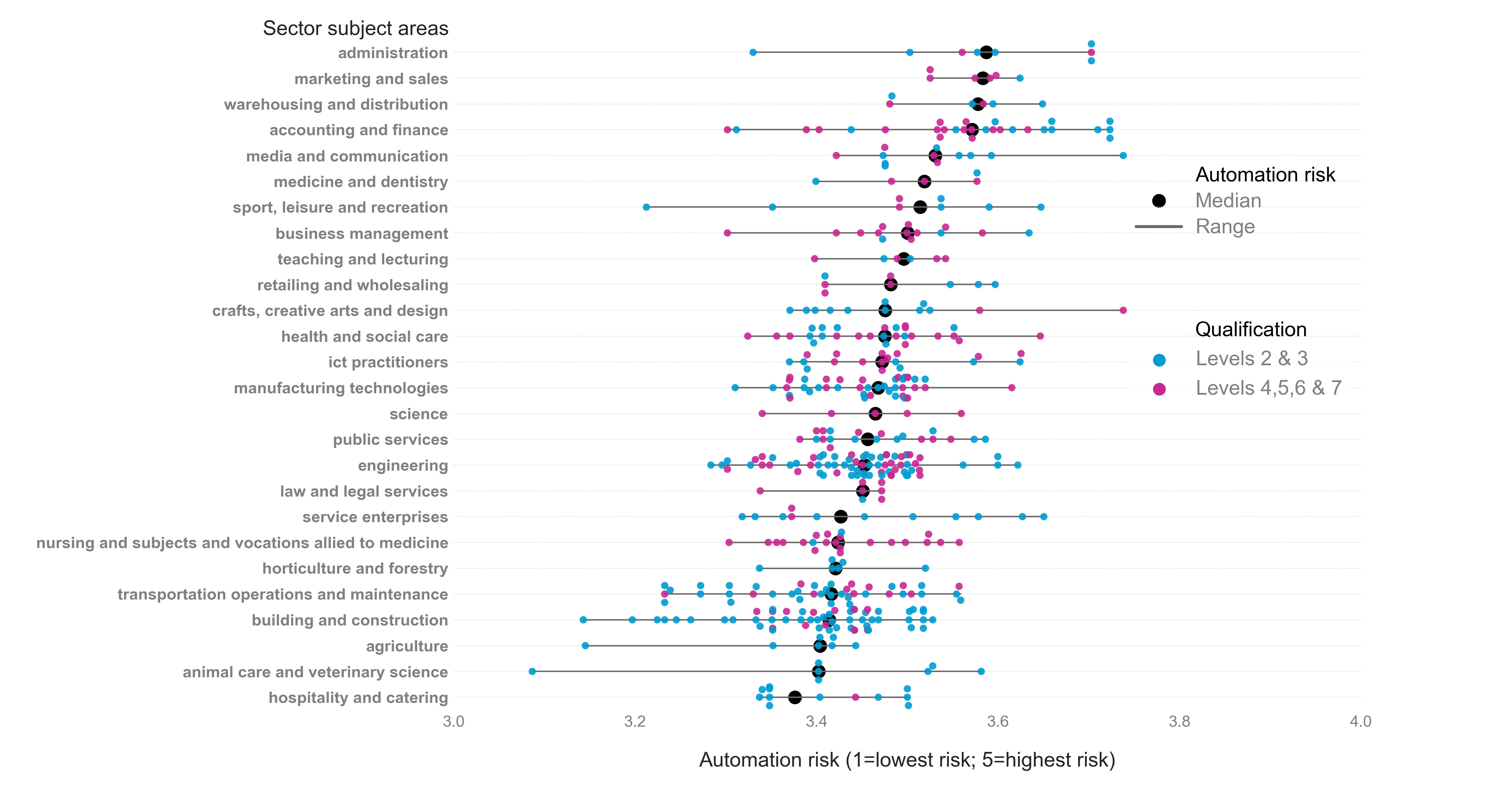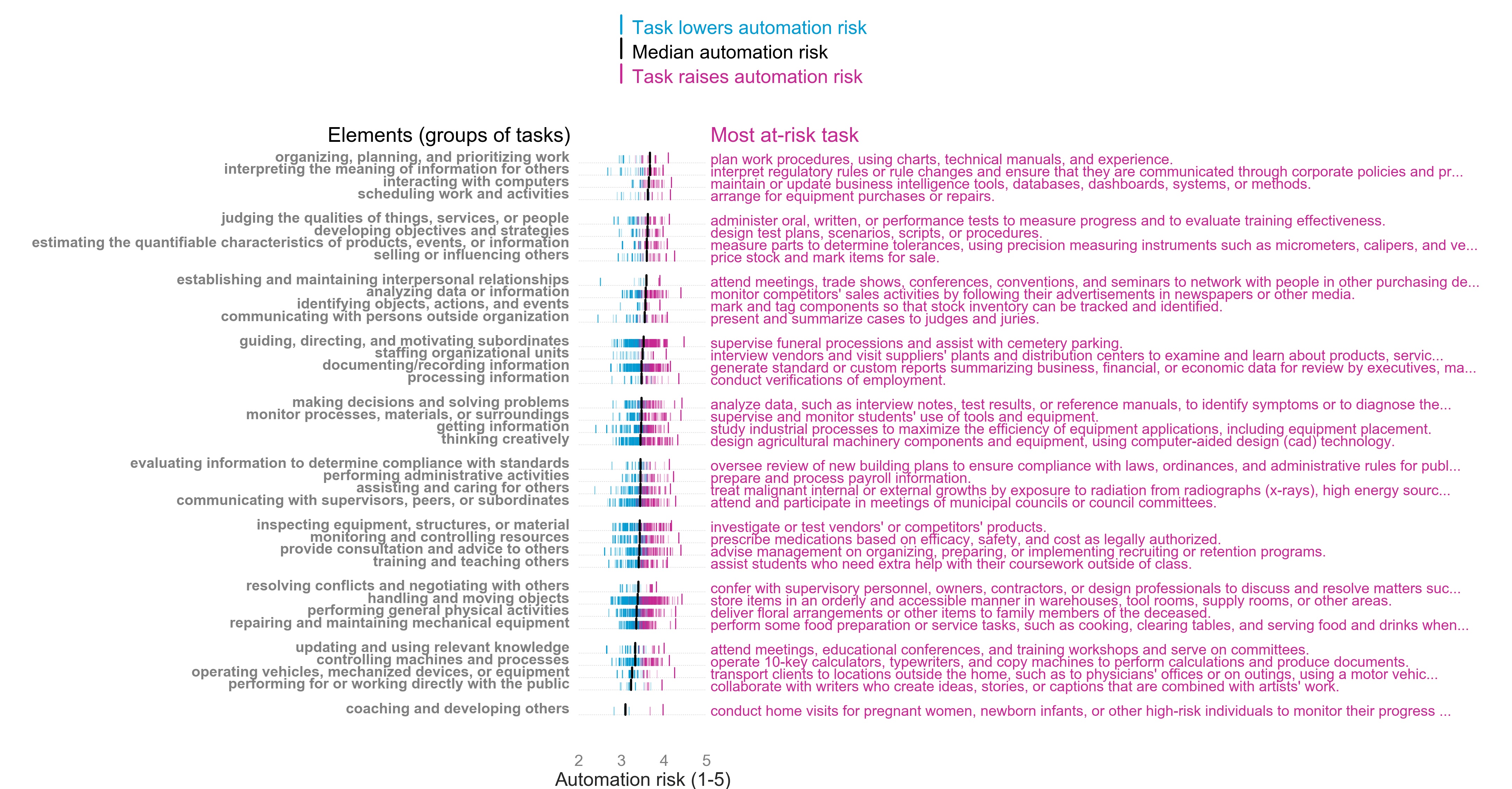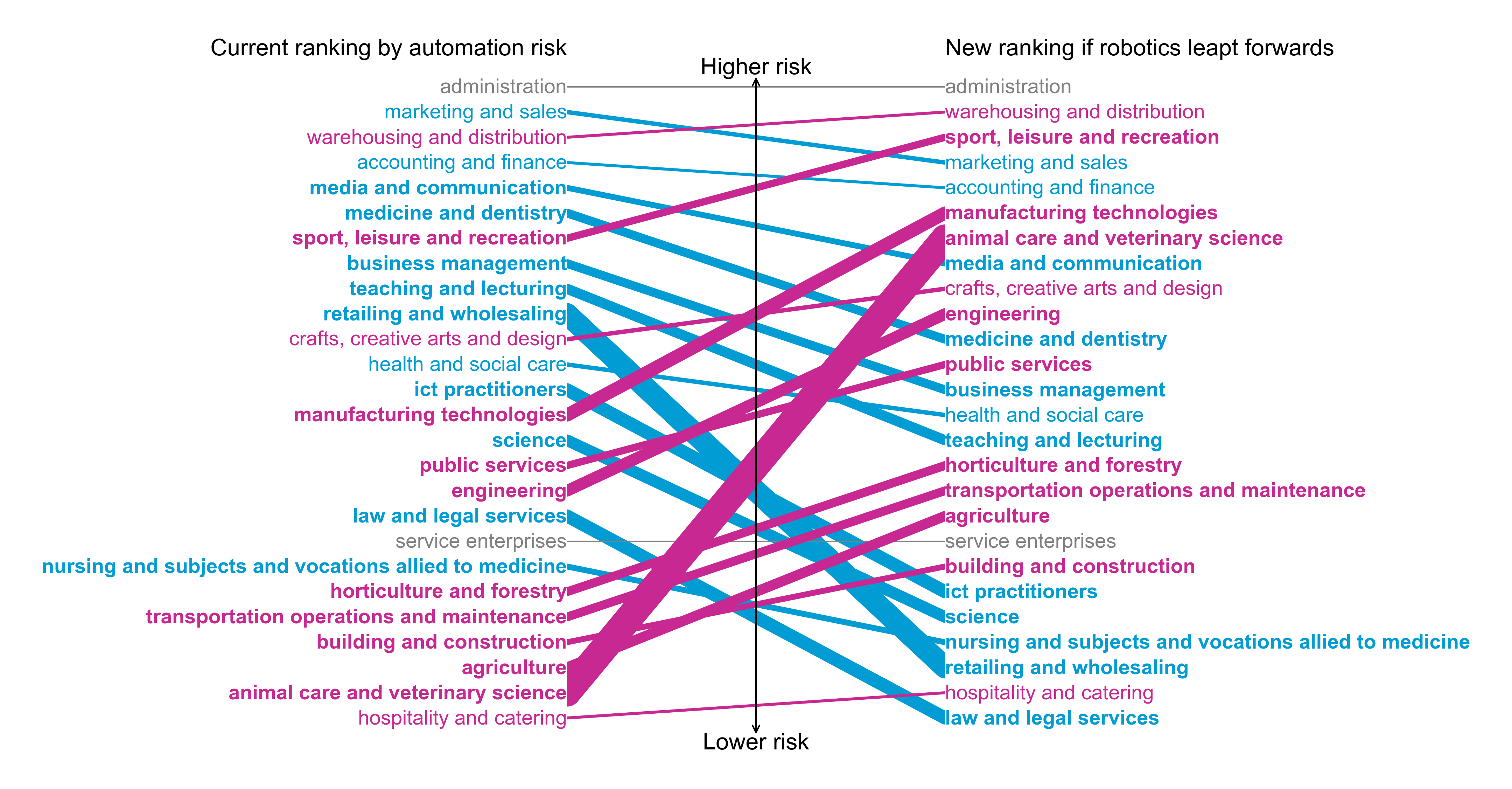Automation risk is an important consideration for young people, as they will experience many more years in the labour market than older workers. Moreover, a recent study by the Office for National Statistics found that young people are more likely to be in roles affected by job automation. Of those aged 20 to 24 years who are employed, the ONS estimated that 15.7% were in jobs at high risk of automation, compared to just 1.3% of workers aged 35 to 39.
This research project was funded by the Gatsby Foundation.
Estimating automation risk is extremely challenging, and in this study we capture one aspect of this risk. Specifically, we estimate the suitability of the tasks within an apprenticeship for machine learning. Suitability for machine learning is a necessary, but not sufficient, condition for task automation. Legal, cultural, financial and organisational barriers may prevent or slow the automation process. In addition, we can only compare the risk of automation between apprenticeships (capturing relative risk) and we cannot estimate the absolute likelihood that an apprenticeship will be automated. Lastly, it is important to remember that a job that is at lower risk of automation is not necessarily a ‘better job’. Work quality is a much broader concept and automation risk is just one component.
Our estimates of automation risk are based on the findings of a US study by Brynjolfsson, Mitchell and Rock (2018). The authors asked participants (via a crowdsourcing platform) to rate the automatability of thousands of work activities that make up US occupations (as described in the O*Net framework). For each work activity, raters were shown an example of a task within that activity and were asked whether they strongly agreed or disagreed with 23 statements, such as ‘this task does not require physical dexterity’ and ‘the outputs of the task do not need to come from a human’. The scores were aggregated across raters to estimate the suitability of thousands of tasks for machine learning. High scores across the statements indicate higher levels of automation risk.
The strength of the Brynjolfsson et. al. approach is that automation risk is estimated for each task separately, which allows a job to contain a mixture of low and high-risk tasks. Some earlier automation studies estimated automation risk for much broader groups of tasks or for whole occupations. This approach made it difficult to isolate the drivers of risk and gave the impression that automation will either eliminate a job entirely or leave it completely untouched. A third outcome, and one that surfaced from Brynjolfsson’s approach, is that many jobs contain a mixture of high and low risk tasks and are therefore more likely to be redesigned rather than disappear entirely. The key limitation of the Brynjolfsson et. al. approach is that it only judges the automation risk of existing tasks. The advances that lead to automation will also generate new tasks, such as the supervision of automated processes, and these tasks may be bundled up to create new jobs and apprenticeships.
To translate the automation scores to a UK context, we manually created a mapping between US occupations and UK apprenticeships (with assistance from The Gatsby Foundation). This crosswalk is available on our Github page and we encourage others to use it and suggest improvements. A total of 498 apprenticeships were matched to one or more US occupations.[1] A small number of (very similar) apprenticeships were mapped to the same US occupation and, as a result, these apprenticeships will share the same level of automation risk. That said, the uncertainty around their automation estimates is likely to be of a magnitude greater than the small differences in their tasks.
Each dot in the chart below represents an apprenticeship, and its position along the horizontal axis indicates its overall risk of automation. The apprenticeships are grouped into sector subject areas, and these are ordered by the median risk of automation across all the apprenticeships that reside in each area.[2] The sector subject areas with the highest risk of automation are administration, marketing and sales, and warehousing and distribution. Conversely, apprenticeships in agriculture, animal care and veterinary science and hospitality and catering have the lowest overall levels of automation risk. However, the chart also shows that there is considerable variation within each sector subject area.
Figure 1: Automation risk by sector subject area and qualification level

Among apprenticeships with at least 500 starters in 2018/19, the highest risk apprenticeships include assistant accountant, recruitment resourcer, insurance practitioner and digital marketer. Many of these apprenticeships are desk-based roles that rely heavily on basic digital skills. The lowest risk apprenticeships[3] include bricklayer, rail engineering technician, senior production chef and hair professional. A number of these lower-risk apprenticeships involve confronting unstructured problems or working in changeable environments. These features make the apprenticeships more difficult to automate. A large number of these apprenticeships also require physical activity and dexterity. This correlation stems from the rubric used by Brynjolfsson et. al. in which the authors do not incorporate the impact of recent developments in robotics, and so the need for physical labour and dexterity lowers rather than raises the risk of automation. We consider the impact of this choice at the end of the article.
There are two surprising results. First, the qualification level of the apprenticeship is not strongly correlated with its risk of automation. In fact, there are several degree-level apprenticeships, such as business-to-business sales professional and supply chain leadership professional, which are estimated to be at higher risk of automation than most other apprenticeships. Second, several apprenticeships that involve interacting with people also have relatively high automation scores. It appears that a ‘people-based’ role is not enough to lower automation risk. Instead, the risk appears to hinge on the type of communication involved, with a distinction between simply broadcasting information and more complex forms of communication such as negotiation and dispute resolution.
The risk of automation for any given apprenticeship is determined by the risk associated with each of its tasks. The chart below shows the automation risk for the thousands of tasks that are required in apprenticeships. The tasks are grouped into ‘Elements’ (which correspond to broad work activities) and the black dash in each row reflects the median automation risk among tasks within the Element. The smaller (blue and pink) dashes show the tasks that raise (pink) and lower (blue) automation risk for apprenticeships. On the right-hand side of the chart are examples of tasks that have the highest automation score in each Element.
The higher risk Elements include interacting with computers, scheduling work and activities and estimating the quantifiable characteristics of products, events or information. The lower risk Elements include coaching and developing others, operating vehicles, mechanized devices or equipment and performing for or working directly with the public. Crucially, every Element contains a mixture of high and low risk tasks. This means that reducing automation risk is not as simple as getting rid of Elements that raise risk and encouraging those that lower risk.
Figure 2: Automation risk by Element (groups of tasks)

To further demonstrate the variability of automation risk, the figure below shows the automation risk for each of the tasks that live within a single Element: ‘Analysing Data or Information’.[4] Combined, the tasks within this Element raise the risk of automation for apprenticeships, but the figure shows that there are a small number of tasks in this Element that actually lower automation risk. Examples of such tasks include ‘review financial reports to ensure efficiency and quality of security operations’ and ‘analyze survey objectives and specifications to prepare survey proposals or to direct others in survey proposal preparation’.
Figure 3: Automation risk for tasks within one Element: ‘Analysing Data or Information’

In an effort to provide further clarity about the drivers of risk, we studied smaller groups of tasks, called Intermediate Work Activities (IWAs)[5]. As the chart below shows, we found that the large majority of IWAs (85%) still contained a mixture of tasks that raise and lower automation risk for apprenticeships. However, there were a small number of groups (which are labelled and given larger bars) where almost all the tasks (at least 90%) either raise risk, or lower risk. Examples of groups whose tasks uniformly raise risk include calculating financial data, fabricating devices or components and evaluating production inputs or outputs. Conversely, the groups whose tasks all lower risk include applying hygienic or cosmetic agents to skin or hair, training animals and creating artistic designs or performances.
Figure 4: Automation risk for Intermediate Work Activities (IWAs)

This section has shown that automation risk can vary substantially between seemingly similar tasks. However, broadly speaking, the risk of automation for apprenticeships appears to be raised by one-way routine interactions with people or machines (such as monitoring, analyzing and reading), and lowered by the following factors:
A bottleneck task is one which is particularly difficult to automate. Examples of bottlenecks include tasks which require physical dexterity, complex conversation, or have no room for error. These tasks are important because they may prevent or slow the automation process, even for apprenticeships that contain many other tasks that are suitable for machine learning.
The chart below shows the factors that provide bottlenecks for apprenticeships. As a reminder, Brynjolfsson et. al. assessed suitability for machine learning by asking participants how strongly they agreed with 23 statements about each task, using a scale of 1 to 5. We judge that a task is acting as a bottleneck if it gained a score of less than or equal to 2 (out of 5) for at least one of these statements.
Figure 5: Sources of bottlenecks for apprenticeships

Most bottlenecks in apprenticeships come from just two sources: the requirement for high dexterity and the need for physical labour and movement. A leap forward in robotics may render these bottlenecks ineffective. To explore this risk, we recalculate the automation scores for apprenticeships, excluding the statements related to physical movement and dexterity (thereby assuming that these factors would no longer lower automation risk).
The chart below shows how the leap forward in robotics would alter the sector subject areas that are most exposed to automation risk.[6] The colour indicates whether robotic innovation would raise or lower the sector’s ranking, and the thickness of the line indicates the number of places by which the sector’s ranking would change. Almost all apprenticeships experience an increase in risk, but the impact is not evenly spread. The greatest increases in risk are experienced by apprenticeships in manufacturing, animal care and veterinary science, engineering and agriculture. While analysts predict that the automation of physical dexterity and labour may only become widespread in the mid 2030s, rapid innovation in robotics would force policy makers to switch their focus towards these sectors.
Figure 6: Impact of robotic innovation on relative automation risk among apprenticeships

In conducting this analysis, a curious result arose: both funeral directors and church ministers appear in the top 30 apprenticeships at greatest risk of automation. [In the Brynjolfsson et. al. study, ‘Morticians, Undertakers, and Funeral Directors’ also came in the top 5 occupations with the highest suitability for machine learning.] We discovered a number of tasks in the two apprenticeships that were judged by participants in the study by Brynjolfsson et. al. as being highly automatable, despite these tasks requiring visible displays of emotion which seem hard to automate. For example, the tasks of funeral directors include ‘consult with families or friends of the deceased to arrange funeral details, such as obituary notice wording, casket selection, or plans for services’ and this task scored 4.1 out of 5 for automatability. Similarly, the tasks for church ministers include ‘respond to requests for assistance during emergencies or crises’ which scored 4.2 out of 5 and ‘visit people in homes, hospitals, or prisons to provide them with comfort and support’ which scored 4.0 out of 5.
The tasks described above all require affective labour, where the worker is aiming to modify the emotional experiences of others. Across the descriptions of tasks in O*Net, the need for affective labour is often not made explicit, or it is combined with a routine (and automatable) task. If the modification of emotion is essential to the task, and if this can’t be achieved by a machine, then we may be overestimating the automatability of some activities.
While the tasks above all require substantial displays of emotion, many other tasks may require more subtle displays (such as delivering customer service with a smile). Affective labour is not typically identified or valued in automation studies, but it could provide a new bottleneck that slows or prevents automation.
This short study has shown that while some apprenticeships are at higher risk of automation than others, automation risk depends critically on the tasks that make up each role. Rather than dismissing an entire apprenticeship as ‘automatable’ we should examine the individual tasks that raise risk.
Broadly speaking, automation risk for apprenticeships appears to be raised by one-way routine tasks and it is lowered by tackling unstructured problems in variable environments. That said, even within a group of similar tasks that collectively raise risk, there are often narrower tasks that can lower risk. This is a positive finding, as it suggests that some high-risk tasks could be substituted for similar lower risk ones.
Innovation in robotics could be particularly damaging for apprenticeships, because most of the bottlenecks for apprenticeships (which slow automation) are due to the apprenticeship requiring physical effort or dexterity. If robotics leapt forwards, then these requirements would no longer act as a barrier to automation.
The results of this study also raise new avenues for researchers. First, we know very little about the relationships between tasks, and the extent to which one task is a prerequisite to a more advanced task. The automation of these ‘stepping-stone’ tasks would be particularly concerning as it could prevent workers progressing to lower-risk roles. Second, more research is required to identify tasks involving ‘affective labour’, and we should explore whether this requirement is providing an effective bottleneck against automation.
There are a number of practical steps that could reduce the potential impact of automation on apprenticeships. They are:
[1] We were unable to include apprenticeships in the emergency services and armed forces, as these were excluded from the Brynjolfsson et. al. study. In addition, some apprenticeships were too broad to be matched to a US occupation: assessor / coach, public service operational delivery officer, project manager (degree), associate project manager and policy officer. Conversely, a handful of apprenticeships were too specific to be matched to a US occupation: bid and proposal coordinator, maritime caterer, hire controller (plant, tools and equipment), historic environment advice assistant, organ builder, farrier and harbour master.
[2] Only areas containing at least 5 apprenticeships are shown.
[3] With at least 500 starters in 2018/19.
[4] Only include tasks that are required in apprenticeships.
[5] We only considered IWAs that contained at least 10 tasks which were required in apprenticeships.
[6] Only areas containing at least 5 apprenticeships are shown.